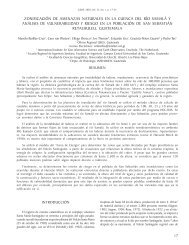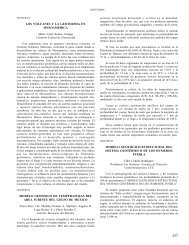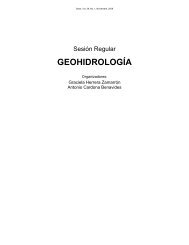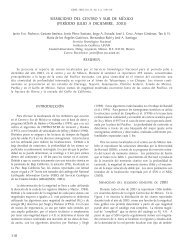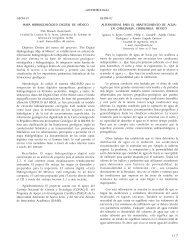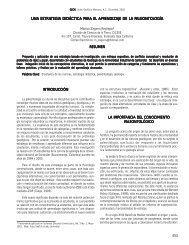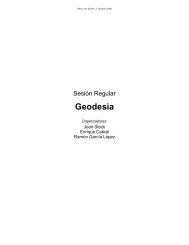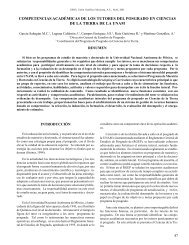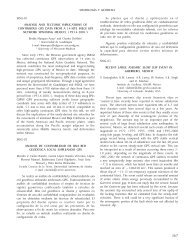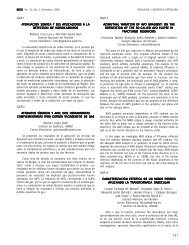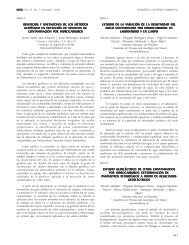Libro de resúmenes [revisión final, 172 páginas] - UGM
Libro de resúmenes [revisión final, 172 páginas] - UGM
Libro de resúmenes [revisión final, 172 páginas] - UGM
Create successful ePaper yourself
Turn your PDF publications into a flip-book with our unique Google optimized e-Paper software.
Geos, Vol. 27, No. 1, Octubre, 2007EXPLORACIÓN GEOFÍSICAValores específicos <strong>de</strong>l factor <strong>de</strong> calidad Q no son <strong>de</strong>tectables<strong>de</strong> ser <strong>de</strong> valores relativamente bajos y sus efectos son evi<strong>de</strong>ntesa altos. El espectro <strong>de</strong> amplitud asociado con el fenómeno <strong>de</strong>absorción, se manifiesta atenuado mas severamente a altasfrecuencias en comparación <strong>de</strong> lo que ocurre a bajas frecuenciasen los casos dispersivos y no dispersivos. Las respuestas <strong>de</strong> losmo<strong>de</strong>los con valores <strong>de</strong> Q constantes para los casos dispersivosy no dispersivos revelan que la amplitud <strong>de</strong>crece con una tasamayor para valores relativamente altos que bajos.Cabe indicar que las consi<strong>de</strong>raciones anteriores constituyenla fase preliminar en la mo<strong>de</strong>lación <strong>de</strong> la propagación <strong>de</strong>ondas acústicas con dispersión y atenuación en el dominiotiempo-frecuencia orientado a la obtención <strong>de</strong> los parámetros <strong>de</strong>atenuación <strong>de</strong> secciones sísmicas.EG-22ATTENUATION ANISOTROPY: COMPARISONBETWEEN THEORY AND LABORATORY EXPERIMENTChichinina Tatiana y Ronquillo Jarillo GerardoInstituto Mexicano <strong>de</strong>l Petróleotchichin@imp.mxThis investigation is related to the attenuation anisotropy forfracture characterization from surface seismic reflection data.In frames of transversely isotropic (TI) mo<strong>de</strong>l with horizontalsymmetry axis, azimuthally <strong>de</strong>pen<strong>de</strong>nt seismic quality factor Qis attempted to be used in estimation of crack orientation fromreflection seismic data. The crack-direction estimation is based onthe assumption of cos(2phi)-trend in azimuthal variation of P-waveattenuation. We have <strong>de</strong>rived an analytical formula for P-waveattenuation in TI media as a function of propagation directionand <strong>de</strong>veloped QVOA method based on this formula (QVOA isQ-Versus-Offset-and-Azimuth, Chichinina et al, 2006).Our goal is in verifying theoretical i<strong>de</strong>as on the attenuationanisotropy by means of ultrasonic laboratory experiment. Toimitate fracture medium with aligned cracks, a mo<strong>de</strong>l consistingof rectangular plexiglas plates (each 1 mm thick) was used. Theplates are held on together by compressing uniaxial pressureapplied to the upper and bottom si<strong>de</strong>s of the mo<strong>de</strong>l. The sourceis situated on one si<strong>de</strong> of the mo<strong>de</strong>l, and the receivers arepositioned on the opposite si<strong>de</strong> of the mo<strong>de</strong>l on a circle. Thecentre of the circle coinci<strong>de</strong>s with the source-point projection.The location of each receiver point is given by an azimuthalangle phi between the circle radius and the vertical axis z whichis normal to fracture planes. The experiment is performed fortwo mo<strong>de</strong>ls – with oil saturation and without any saturation (drymo<strong>de</strong>l). We get P-, SV- and SH-waves emitted and acquired bypiezoelectric transducers with corresponding directivity functions.The attenuation, or inverse seismic quality factor Q, and velocityvalue V are estimated for each trace, i.e., each angle phi. The<strong>de</strong>tails on the experiment can be found in Gik and Bobrov (1996).Laboratory-experiment results confirmed in general our theoryon the attenuation anisotropy in fractured rocks with parallelfracture sets. Attenuation anisotropy occurred to be muchgreater than velocity anisotropy. For example, in the oil-saturatedmo<strong>de</strong>l, the P-wave velocity anisotropy is 4%, but the anisotropyof attenuation is much greater, 115%. The <strong>de</strong>pen<strong>de</strong>nces ofattenuation versus propagation direction for dry and saturatedmo<strong>de</strong>ls found experimentally occurred to be in a good agreementwith theoretical predictions. We found out that the ratio of thesymmetry-axis P- and S-wave attenuations, Qp/Qs, was strongly<strong>de</strong>pen<strong>de</strong>nt of fluid (of whether the cracks were dry or saturated).Therefore, we believe that analysis of Q-anisotropy may getpotential use for seismic exploration. The analysis of Q versusoffset (QVO) in seismic P-wave reflection data may serve as anindicator of the crack-fill fluid due to its link to the parameter Qp/Qsas we have found out.Chichinina, T., Sabinin V., and Ronquillo-Jarillo G. [2006]QVOA analysis: P-wave attenuation anisotropy for fracturecharacterization. Geophysics, 71, No. 3, C37-C48.Gik, L. D. and Bobrov, B. A. [1996] Experimental laboratorystudy of anisotropy for thin-layered media. Russian Geology andGeophysics, 37 , No. 5, 94-107.EG-23ESTIMACIÓN DE LA RESISTENCIA UNIAXIALA LA COMPRESIÓN (RUC) Y RESISTENCIAA LA COMPRESIÓN (RC) CON DATOS DELABORATORIO Y REGISTROS GEOFÍSICOS DE POZORonquillo Jarillo Gerardo y Mendiola Sánchez JoaquínInstituto Mexicano <strong>de</strong>l Petróleogronqui@imp.mxSe presentan nuevos mo<strong>de</strong>los o relaciones empíricas para laestimación <strong>de</strong> RC para rocas Calcarenita y Lutita + Mudstone,así como modificaciones para la estimación <strong>de</strong> RUC. Conbase en tiempos <strong>de</strong> transito (su inverso es la velocidad) ymódulos <strong>de</strong> Young (E), con datos <strong>de</strong> laboratorio y registrosónico. Correlacionando y validando los resultados obtenidos<strong>de</strong> los mo<strong>de</strong>los <strong>de</strong> RC, RUC con las propieda<strong>de</strong>s petrofísicas,análisis litológico (con el registro sónico, <strong>de</strong>nsidad y porosidad),elementos mineralógicos ( con registros <strong>de</strong> Potasio y Thorio). Asícomo un análisis Multiescala usando los exponentes <strong>de</strong> Hol<strong>de</strong>r.Primero se efectúa un análisis <strong>de</strong> datos obtenidos <strong>de</strong>laboratorio <strong>de</strong> velocida<strong>de</strong>s tanto longitudinales (Vp), como<strong>de</strong> corte (Vs), Resistencia Uniaxial a la Compresión (RUC),resistencia a la compresión (RC) a con condiciones y sincondiciones <strong>de</strong> yacimiento. Con la <strong>final</strong>idad <strong>de</strong> la obtención <strong>de</strong>mo<strong>de</strong>los o relaciones empíricas <strong>de</strong> RC, RUC y <strong>de</strong> propieda<strong>de</strong>spetrofísicas <strong>de</strong>l medio geológico en particular. Este análisis serealiza para enten<strong>de</strong>r el comportamiento <strong>de</strong> las propieda<strong>de</strong>spetrofísicas y mecánicas <strong>de</strong> las rocas. Segundo se correlacionalos datos <strong>de</strong> laboratorio con los registros <strong>de</strong> pozo principalmentesónicos, <strong>de</strong>nsidad, resistividad, porosidad y volumen <strong>de</strong> arcillapara establecer las relaciones empíricas correspondientes <strong>de</strong>RUC, RC y petrofísicas.Por otro lado los tiempos <strong>de</strong> transito <strong>de</strong>l registro sónico,son obtenidos a condiciones <strong>de</strong>l medio geológico o sea <strong>de</strong>la formación en estudio, por lo que se requiere tener unaaproximación <strong>de</strong> la Resistencia a la Compresión (RC) aesas condiciones consi<strong>de</strong>rando la influencia <strong>de</strong> sus elementosmineralógicos y litología.Por lo tanto se pue<strong>de</strong> concluir que los mo<strong>de</strong>los establecidos yestimados <strong>de</strong> RUC y RC con base en datos <strong>de</strong> laboratorio y losregistros geofísicos <strong>de</strong> tiempos <strong>de</strong> transito y módulos <strong>de</strong> Young,se correlacionan bastante bien con las propieda<strong>de</strong>s petrofísicas<strong>de</strong> los registro <strong>de</strong> velocida<strong>de</strong>s, volumen <strong>de</strong> arcilla, <strong>de</strong>nsidad yotros registros que se analizaron.21


![Libro de resúmenes [revisión final, 172 páginas] - UGM](https://img.yumpu.com/51565067/21/500x640/libro-de-resamenes-revisian-final-172-paginas-ugm.jpg)
